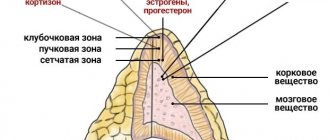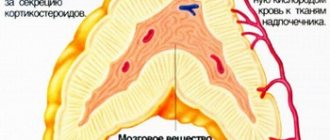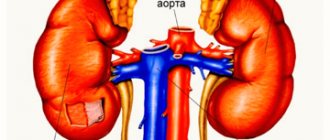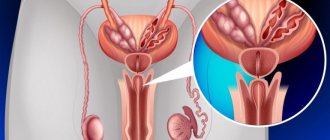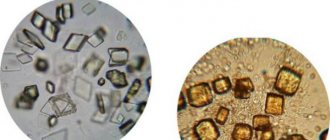The role of the adrenal glands for the normal functioning of the entire body cannot be underestimated. These endocrine glands are necessary for the synthesis of various hormones - adrenaline, corticosteroid hormones, norepinephrine. In addition, the function of the adrenal glands in the body is also to regulate metabolic processes; the adrenal glands help a person adapt to environmental conditions, which are often unfavorable.
The cortex of these paired organs is responsible for water-salt metabolism and is involved in the process of converting protein structures into carbohydrates, and the medulla affects the rhythm of the heart, the metabolism of carbohydrates and the increase in pressure in the arteries. Disruption of the adrenal glands leads to an imbalance in all vital functions of the body. The following will look at what the adrenal glands are, the symptoms of adrenal disease in men, and what therapeutic and preventive measures are necessary for normal adrenal function.
Their functions in the body
These organs perform a number of vital functions :
- Regulation of metabolism, participation in protein metabolism.
- Restoring the body after stressful situations.
- Hormone production.
- Regulation of water-salt balance.
- Increasing the body's endurance, fighting fatigue.
- Improving the functioning of the cardiovascular system.
- Regulation of blood glucose levels.
- Maintaining blood pressure within normal limits.
- Formation of genital organs in a child.
Hyperfunction of the adrenal cortex
Occurs with tumors of the gland and Leydig cells of the testicles, lesions of the hypothalamus, bronchogenic cancer. Hyperplasia, inflammation of the adrenal glands, symptoms in men are divided into sexual and metabolic disorders. However, all of them can be combined for any pathology of paired glands in men and women.
With hyperfunction of the cortex, diseases of the adrenal glands (signs in men) manifest themselves in several conditions.
Primary aldosteronism with the development of hypertension, decreased potassium and chlorine in the blood serum, albuminuria, muscle weakness and seizures.
Cushing's syndrome, associated with metabolic disorders and excessive production of hydrocortisone. It is less common in men than in women. Characteristic features:
- moon-shaped face;
- obesity;
- purple stretch marks on the skin;
- high blood pressure;
- osteoporosis;
- hyperglycemia;
- glucose in urine;
- tendency to develop bruises and pinpoint hemorrhages.
Adrenogenital syndrome with sexual anomalies associated with congenital deficiency of specific enzymes for the formation of steroid hormones. Congenital forms are accompanied by symptoms of pseudohermaphroditism. In young boys, adrenogenital syndrome manifests itself as isosexual premature false puberty. During development, in the postpubertal period, it is expressed by the feminization of the man and the following signs:
- decreased libido and potency;
- small and soft testicles;
- gynecomastia;
- reduction in the size of the penis and prostate;
- loss of body hair.
Some cases of infertility due to underdevelopment of the testicles are the result of male adrenogenital syndrome. Patients with mild pathology often complain of increased fatigue, decreased libido and erectile dysfunction.
The doctor, having a suspicion of adrenal pathology, seeing the symptoms of the disease, will refer you for diagnostics, which consists of conducting laboratory tests to detect a high titer of 17-ketosteroids in the urine and oligospermia. Good results in the treatment of feminization of men are achieved by prescribing prednisone.
Anatomically, the organ consists of two parts: the cortex and the medulla. The first area performs the function of secreting some steroids, in particular sex steroids. The cortex occupies about 90% of the entire organ. The brain part tends to produce catecholamines, which are better known as stress hormones.
Common diseases and their symptoms in men
The most common adrenal gland diseases in males are:
- Benign and malignant neoplasms.
- Congenital dysfunction of the adrenal cortex.
- Decreased functioning of the adrenal glands.
- Hypertrophic changes in the adrenal cortex.
- Addison's disease.
The first symptoms of the disease are:
- Increased fatigue.
- Paleness of the skin.
- Insomnia.
- Nausea.
- Nervousness.
- Loss of body weight.
With the subsequent development of the disease, other distinctive signs appear. With benign and malignant neoplasms, kidney failure occurs and swelling is noticeable.
There are periodic pains in the kidney area, loss of appetite. In the later stages, a person becomes exhausted, lies down a lot, and complains of pain in the kidney area. Vomiting occurs.
If the functioning of these organs has decreased, then there is congenital dysfunction of the adrenal cortex, the patient has pain in the head and abdomen. Metabolism is disrupted, body weight decreases. Blood pressure rises periodically. The person becomes irritable.
With adrenal insufficiency, vision deteriorates and headaches often occur. The person becomes pale and gets tired quickly. Appetite disappears, insomnia appears.
Types of diseases
There are many types of adrenal gland lesions. Only specialists can understand the features of such ailments and prescribe treatment. The problem is that men go to the doctor when the disease has already caused serious damage to the body. The role of early diagnosis in such pathologies is enormous.
Hormonally inactive formations
Neoplasms of a benign and malignant nature can remain undetected for a long time, since signs of their development appear in the later stages of tumor growth. Typically, such a pathology is discovered by chance, during the diagnosis of MRI or CT.
Types of diagnosed tumors in men:
Formations in the medulla: less commonly ganglioneuroblastoma, more often pheochromocytoma.- Formations in the adrenal cortex: nodular hyperplasia, adenoma, carcinoma.
- Metastases that have spread from the mammary glands, as well as from the lungs.
- Diseases of the glands themselves: xanthomatosis, neurofibroma, granuloma, amyloidosis, hematoma, cyst, angiosarcoma, lipoma.
The disease is diagnosed by determining its nature and course, its effect on hormone production, and then a course of therapy is prescribed.
Manifestations of adrenal gland pathologies:
- myalgia;
- weight gain;
- arthralgia;
- diabetes;
- increased blood pressure (hypertension).
The symptoms of such disorders are quite varied in men; it is impossible to accurately determine the sign of a particular ailment without diagnosis. To examine such a patient, CT (computed tomography) and ultrasound are used.
Treatment of a benign tumor that is less than 3 cm in diameter does not require surgery. A man should be constantly monitored by a doctor to diagnose and identify the growth of the formation.
Drug therapy, in this case, is not required, since there are no symptoms with such a tumor size. If the formation is malignant and large, it is removed surgically.
Adrenal hypertrophy and hormonally active formations
Tumors that increase the synthesis of adrenal hormones are considered hormonally active. Such formations usually provoke the appearance of vivid symptoms, which makes a trip to the doctor a necessity.
| Tumor type | Reasons for development | Symptoms | Treatment |
| Corticosteroma (Cushing's syndrome) | The brain produces excess adrenocorticotropic hormone or tumor formation in the adrenal cortex |
|
|
| Aldosteroma (Conn's disease) | Excessive production of the cortex glands, the hormone aldosterone. Tumor development in the glands. | Hypertension. Weakness in the muscles of the body. Convulsive manifestations | Surgical removal of the adrenal gland, after which the man must take hormonal medications for life |
| Corticosteroma and androsteroma | The appearance of a tumor on the adrenal gland. Increased production of male sex hormones | A man's appearance begins to resemble a woman's. Hair falls out on the body and head. Female type obesity. Weakening or complete absence of potency | Therapy is aimed at reducing the synthesis of male sex hormones |
| Phaeochromcytoma | Excessive production of catecholamines, which provoke the growth of tumors of the adrenal medulla | Abrupt increase in pressure. Anxiety attacks. Fever. Migraine. Painful sensations in the heart. Fast weight loss | Surgical removal of a tumor on the adrenal gland. Therapy with drugs that interfere with the effects of adrenaline and norepinephrine |
Causes of problems
Pathologies develop for the following reasons:
- Infectious diseases.
- Hormonal imbalance.
- Bad habits: smoking, drinking alcohol.
- Genetic predisposition.
- Impaired blood circulation.
- Congenital adrenal defects.
- Brain injuries.
- Frequent stressful situations.
- Decreased immunity.
- Disturbances in the functioning of the cardiovascular system.
- Chronic nephritis.
- Liver pathologies.
Why does the functional activity of the adrenal glands decrease?
The function of paired endocrine glands sometimes begins to decline with Addison's disease. The disease is diagnosed in rare cases. Men with this syndrome experience a lack of the stress hormone cortisol in their bodies.
Often, the disease can occur for the following reasons:
for tuberculosis; during the formation of glandular tumors or at the time of their metastasis; due to embryonic underdevelopment of the paired organ; against the background of hereditary genetic defects; if the endocrine glands lose sensitivity to adrenocorticotropic hormone.
According to doctors, if a patient takes corticosteroid hormonal drugs for a long time, without listening to the opinion of specialists, then he increases the risk of getting an iatrogenic form of Addison's disease.
Such an illness can occur in the form of a hidden illness, especially if the patient does not often have to experience negative emotions. However, in the event of a sudden severe shock, the symptoms of Addison's syndrome may appear unexpectedly in the form of the following ailments:
IT IS IMPORTANT TO KNOW!
PARASITES, which infect 7 out of 10 Russians, are the main culprit of the pungent odor of urine, discharge and kidney disease. Find out what Elena Malysheva advises in the program “Live Healthy”... >>>
signs of tachycardia and low blood pressure; a man may become more depressed and anxious, hot-tempered, he begins to be irritated by everything; paralysis with loss of sensation in the lower extremities; decrease in the total volume of circulating blood; pathological decrease in the amount of fluid in the body; darkening of some parts of the body, mucous tissues; loss of appetite and weight loss; impairments in cognitive abilities.
In medical terminology, one can distinguish “Addisonian crisis” - such a disease is dangerous because it can cause acute renal failure in the body of a sick man. Often, such an illness occurs as a result of a sharp refusal to take corticosteroids or a decrease in the dose of their intake, when treatment necessarily requires a gradual reduction in the use of hormonal drugs.
To stop the development of such a disease, the patient is prescribed hormonal drugs that replace the lack of cortisol with hydrocortisone or florinef while reducing the level of the mineral corticosteroid aldosterone. This may also include drugs that help normalize blood pressure and restore the content of potassium cations in the blood while combating dehydration.
How to test your adrenal glands?
Modern diagnostic methods are used to check the condition of the adrenal glands :
- Blood and urine tests.
- CT scan.
- Hormonal tests.
- Magnetic tomography.
- Ultrasound examination of the adrenal glands.
Read our article on how to do an ultrasound scan of the adrenal glands.
These methods are quite sufficient to determine the condition of organs and identify diseases. Only after these methods have been carried out, the doctor prescribes treatment for the patient .
Adrenal insufficiency
- Addison's disease with decreased cortisol production.
- Hypoaldosteronism. A very rare disease, since more often patients have insufficiency of other adrenal hormones. Manifested by hyperkalemia and Adams-Stokes syndrome.
- Hemorrhage into the adrenal glands.
Let's take a closer look at hypocorticism (Addison's disease), how adrenal disease is diagnosed, symptoms, treatment in men. The disease was discovered and described in detail by a British doctor and was named after him.
Addison's disease
This is a rare endocrine disease. The causes of development are tuberculosis or chemical destruction of tissue, gland atrophy, amyloidosis, purulent infections, metastases of malignant tumors in the adrenal glands.
Treatment with medications
If the disease is caused by hormonal imbalance , men are prescribed medications:
- Andriol.
- Methyltestosterone.
- Androderm.
These drugs restore hormonal levels and normalize metabolism. Typically, this method is used at the initial stage of the disease, in which case the functions of the adrenal glands are normalized.
The dosage and course of treatment are prescribed by the doctor.
For severe pain caused by pathology, it is recommended to take painkillers:
- No-shpa.
- Aspirin.
- Analgin.
They do not cure the disease, but alleviate the patient’s condition by eliminating pain of various types.
If the disease is caused by infection , antibacterial drugs are prescribed:
- Cefotaxime.
- Ceftriaxone.
- Streptomycin.
These drugs have a strong effect, so they are taken only with a doctor's prescription in a strictly prescribed dosage.
Also, during treatment, men are advised to give up cigarettes and alcohol and avoid stress. You need to lead a healthy lifestyle, eat more vegetables and fruits. Increased physical activity and heavy lifting will have to be avoided. These measures promote recovery.
What role do the adrenal glands play?
What are the main roles performed by the adrenal structures in the male body:
- are responsible for the preservation of water and electrolyte balance;
- contribute to an increase in glucose in the bloodstream;
- maintain physical endurance and maintain performance;
- normalize blood pressure in blood vessels;
- are responsible for the restructuring of hormonal levels during puberty;
- trigger the activity of the central nervous system.
Diseases of the adrenal glands not only affect the general well-being of a man, but also have a detrimental effect on his psycho-emotional sphere. If a man’s endocrine glands begin to get sick, he becomes less good-natured and more embittered towards others.
When adrenal dysfunction manifests itself, signs of obesity also appear on a man’s body. In addition, the amount of vegetation on his body decreases, sexual activity fades, to the point that the man completely loses sexual desire.
Folk remedies
To normalize the functioning of the adrenal glands, folk remedies are used. They help only at the initial stage of pathologies.
An infusion of black currant leaves is effective . To prepare it, mix a tablespoon of crushed leaves and a glass of boiling water. The solution should infuse for two hours, then it is filtered. The finished product is consumed 1/3 cup twice a day.
An infusion of succession will help restore the health of the adrenal glands . To do this, you need to mix two tablespoons of the plant and 500 ml of boiling water. The solution should be infused for one hour, after which it is filtered and consumed half a glass twice a day.
If the pathology has developed significantly and a neoplasm has appeared, surgical intervention , during which the tumor is removed. The operation lasts from 50 to 90 minutes depending on the stage of the disease.
After this, there is a long recovery: for two months the patient sees a doctor regularly, takes prescribed medications, lies down a lot and eats only healthy food.
The operation is used only as a last resort. Usually medications and a healthy lifestyle help cure the patient.
How is diagnosis carried out?
First of all, you need to visit an endocrinologist who will examine and prescribe the following tests:
- Blood test and urinalysis;
- Magnetic resonance imaging (MRI);
- X-ray diagnostics of the head to determine the size of the pituitary gland;
- Non-hormonal tests;
- X-ray of bone tissue if osteoporosis is suspected;
- The so-called “radiation study” is a new study to obtain information about the functioning of the adrenal glands, the condition of nearby tissues and organs;
- Scintigraphy to prescribe the correct treatment.
Prevention of adrenal diseases
To prevent the development of pathologies, it is recommended to follow preventive measures :
- Maintaining a healthy lifestyle: giving up cigarettes and alcohol, eating healthy foods, exercising.
- Avoiding stress and anxiety.
- Regular medical examination.
- Visit the hospital at the first sign of illness.
- Following a daily routine.
The adrenal glands in men can become diseased for various reasons. If this happens, you must go to the hospital without delay. Timely diagnosis and proper treatment will lead to a speedy recovery.
An endocrinologist will tell us in a video about the most common diseases of the adrenal glands and how to avoid them using preventive methods:
A little about the adrenal glands
The human endocrine system is a rather complex system that is responsible for the state of a person’s hormonal levels. This system consists of glands and organs, all of which are certainly important for the functioning of the body, however, the most important glands are the pancreas, thyroid gland and our area of interest - the adrenal glands. Most people know, or have at least heard, about the first two glands, but not everyone has an idea about the function and importance of the adrenal glands.
This is a very big omission, since as a result of a malfunction of this paired gland, quite severe pathologies can develop. The glands discussed in this article are located in the retroperitoneal space above the upper part of the kidneys. As already mentioned, the function of the adrenal glands is hormonal synthesis and participation in metabolic processes.
It is safe to say that the adrenal glands are very powerful reserves of the human body. If they function normally, then when stress occurs, a person does not feel weak and tired, that is, he can cope with stress without harming his health. If, after stress, a person cannot calm down for a long time, becomes nervous, develops severe weakness, panic attacks, etc., then the adrenal glands are not functioning correctly. In this case, frequent stress will lead to an increase in the size of these glands, and if a person develops long-term depression, the adrenal glands may completely stop working properly, which will lead to various diseases associated with insufficiency of enzymes and hormones.
Hormones produced by the adrenal glands are very important for human life and are responsible for almost all processes occurring in the body:
- Adrenaline is the main hormone that fights stress. Its concentration in the blood increases both during negative emotions and during joyful and positive events. When adrenaline is released, a person’s pupils dilate, breathing quickens, strength appears, the body becomes less vulnerable to pain, it becomes more resilient and stronger.
- Norepinephrine is a precursor to adrenaline, in other words, it is a stress hormone. What is he responsible for? Although it has less effect on the body than adrenaline, it increases pressure in the arteries, which allows the heart to work harder.
- Corticosteroid hormones can be of three types - glomerular, fascicular and zona reticular hormones.
- In the zona glomerulosa, the glands produce: aldosterone, corticosterone and deoxycorticosterone.
- The synthesis of cortisol and coricosterone occurs in the zona fasciculata.
- Sex hormones - androgens - are produced in the reticular zone. They influence a person’s sex drive, fat levels, and an increase in fat and muscle mass.
All of the above suggests that the adrenal glands perform an important and irreplaceable function in the human body; when their work fails, hormones begin to be produced either in insufficient or in excess quantities, which leads to various pathologies in the body.
Hormones of the adrenal medulla
The structure has a central location in the adrenal gland and is formed by chromaffin cells. The medulla is a sympathetic plexus that secretes hormones directly into the bloodstream. Catecholamines are formed when a stimulus is activated by an external signal.
The effect is on the central nervous system, stimulating the posterior nuclei of the hypothalamus, then the sympathetic centers of the thoracic spinal cord. The signal enters the adrenal glands via preganglionic fibers, adrenaline and norepinephrine are synthesized and released into the blood.
Adrenalin
The hormone has the following effects:
- increases the speed of mental activity, enhances concentration;
- provokes spasms of small vessels, kidneys, skin, intestines;
- speeds up and strengthens heart contractions;
- promotes involuntary defecation, urination, reduces intestinal motility;
- causes panic attacks - unreasonable fear, accompanied by shortness of breath and rapid heartbeat;
- increases blood pressure;
- stimulates metabolic processes, rapid combustion of glucose, breakdown of fats;
- increases the depth and frequency of breathing;
- relaxes the muscles of the uterus, reducing the risk of miscarriage.
Norepinephrine
The hormone has the following effects:
- increases peripheral vascular resistance, increases diastolic and systolic pressure;
- has a strong vasoconstrictor effect, but has less effect on cardiac activity than adrenaline;
- improves the contractility of the smooth muscles of the uterus, stimulates labor;
- has a slight effect on the muscles of the bronchi and intestines.
Instrumental methods
How to check the adrenal glands using instrumental diagnostics? Laboratory tests alone are not enough to make a correct diagnosis. Once the blood, urine and saliva tests reveal certain problems, the doctor may refer the patient for further testing of the adrenal glands. Diagnostics includes:
Compared to ultrasound, which shows only the size of organs and foreign inclusions that may be present in them, CT and MRI are much more informative methods. In this case, a more detailed diagnosis of the kidney and adrenal glands is carried out. The procedure can be performed with or without a contrast agent. No preparation is needed for the procedure; the only condition is to remove all metal objects, including watches and belts.
Other pathologies
The disease occurs equally in men and women aged 20-40 years. Symptoms manifest as hypotension.
p, blockquote 78,0,0,0,0 —>
At the same time, the secretion of gastric juice and mineral metabolism are disrupted, and glycogen synthesis decreases. The disease is accompanied by depression. Later, hypotension with tachycardia occurs.
p, blockquote 79,0,0,0,0 —>
Other pathologies of the adrenal glands include apoplexy. This syndrome can occur in infants after childbirth or against the background of hemorrhage into an organ.
p, blockquote 80,0,0,0,0 —>
Conn's syndrome is a disease of the adrenal glands that is detected using CT. The main symptoms of the disease include hypertension, migraine, cardialgia.
p, blockquote 81,0,0,0,0 —>
Later, convulsions, myalgia, and polyuria may occur. The clinic is associated with high production of mineralocorticoids.
p, blockquote 82,0,0,0,0 —>
p, blockquote 83,0,0,0,0 —>
If this syndrome is suspected, blood biochemistry is prescribed. Sometimes doctors diagnose ganglioneuroma, a benign tumor.
p, blockquote 84,0,0,0,0 —>
Against the background of corticosteroma, hypercortisolism may occur. Disease polymorphism is associated with excessive amounts of hormones secreted by the tumor.
p, blockquote 85,0,0,0,0 —>
Less commonly, doctors detect myelolipoma, a benign neoplasm consisting of fat cells.
p, blockquote 86,0,0,0,0 —>
This tumor is inactive, so it is not accompanied by a bright clinic. It is more often detected in people over 60 years of age.
p, blockquote 87,0,0,0,0 —>
Incidentaloma is detected as a bulk tumor of malignant or benign etiology.
p, blockquote 88,0,0,0,0 —>
Clinically it is distinguished by unclear manifestation or polymorphism. The above neoplasms require in-depth differential examination.
p, blockquote 89,0,0,0,0 —>

